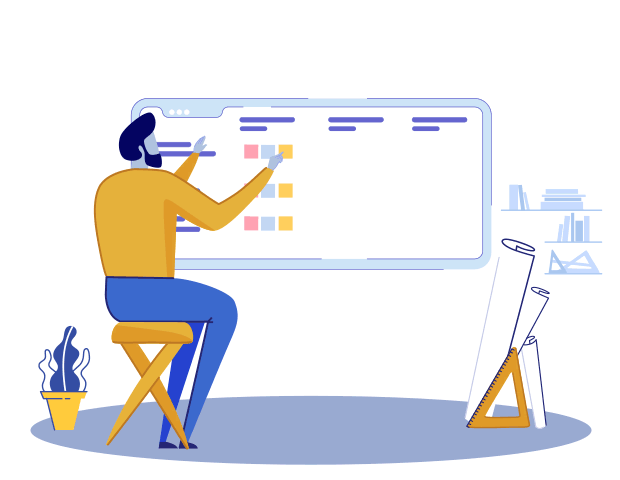Agility Unleashed!
In an era where market dynamics change at a blink, corporations face the formidable challenge of keeping up with an unpredictable business environment. To navigate these turbulent waters, Agile methodology has emerged as an indispensable compass, guiding companies towards a realm of efficiency, responsiveness, and continued growth.
Borne from the software development world, Agile has transcended its initial boundaries, finding a home in a wide array of industries. It has rapidly evolved from a novel concept into an essential strategy, offering organizations a robust framework to survive and flourish amidst competition and constant change. Its inherent emphasis on adaptability, customer-centricity, and continuous improvement has proven transformative for corporates.
Founded on the Agile Manifesto's principles, Agile methodology highlights adaptability, customer collaboration, and continuous improvement as catalysts for business success.
In this article, we delve into the heart of Agile methodology, revealing its potency as an instrument of corporate metamorphosis. We will explore the core Agile techniques — from Scrum and Kanban to Lean and Extreme Programming — and elucidate how they foster collaboration, fuel innovation, and facilitate faster delivery of quality results.
So, whether you are a C-suite executive contemplating organizational overhaul or a team leader seeking to enhance project outcomes, strap in for an insightful journey into the world of Agile. The Agile approach, when fully embraced, promises not only improved productivity but also a cultural shift that places value, transparency, and flexibility at the heart of a corporation's operations. Welcome to the future of corporate project management.
The Upside for Large Corporations
In a world where change is the only constant, Agile methodology offers a lifeline to corporations seeking to stay afloat and ahead. Large corporations, with their complex structures and multifaceted operations, stand to gain immensely from adopting Agile. Here are some of the key benefits:
- Improved Product Quality: Agile emphasizes incremental development and regular testing, which leads to early identification and resolution of defects. This, coupled with the focus on stakeholder engagement, ensures the end product aligns perfectly with user expectations and requirements.
- Enhanced Customer Satisfaction: Agile fosters a culture of customer-centricity. By incorporating customer feedback into every iteration, Agile ensures the final product or service closely aligns with customer needs, thereby boosting satisfaction and loyalty.
- Increased Project Control: Agile's iterative approach gives stakeholders and project managers more opportunities for control and course correction. Regular check-ins, reviews, and retrospectives offer visibility into the project's progress and obstacles, enabling prompt action.
- Faster Time to Market: Agile methods, with their emphasis on 'value-driven delivery,' allow corporations to release the initial product faster and then continue to improve it based on real-time feedback. This approach facilitates rapid delivery of solutions and a competitive advantage in the marketplace.
- Reduced Risks: Agile significantly reduces the risk of absolute project failure. Its iterative nature means features are delivered incrementally, ensuring some level of project success, even if not everything goes as planned.
- Adaptability to Change: Agile methodology is designed to embrace change. In an uncertain business environment, the ability to adapt to new situations, market shifts, or changes in customer preferences is invaluable.
- Boosted Employee Morale: Agile encourages collaborative work and empowers teams by involving them in decision-making processes. This heightened sense of ownership and engagement can boost employee morale and lead to higher productivity.
- Efficient Resource Management: Agile methods allow large corporations to effectively manage resources. Prioritizing tasks based on their business value ensures that efforts and resources are directed towards high-value tasks first.
In short, the Agile methodology gives big businesses the tools they need to react fast and effectively to internal dynamics, customer preferences, and market developments. These businesses can improve their capacity to innovate, deliver, and lead in their own industries by adopting Agile.

Agile and Scrum Training Catalogue
Unleashing Potential in Small Businesses
While Agile methodology's transformative power has been recognized by large corporations, its impact on small businesses is equally significant, if not more so. For small businesses, where every decision can have immediate and wide-ranging consequences, Agile's iterative, feedback-driven approach can be a game-changer. Here are some of the key benefits:
- Accelerated Time to Market: For small businesses operating in competitive markets, speed is critical. Agile, with its iterative development and delivery approach, enables them to launch a minimum viable product (MVP) quickly, then refine and expand it based on real-world feedback.
- Customer-Centric Approach: Small businesses often thrive on customer relationships. Agile, with its emphasis on involving customers throughout the product development process, helps strengthen these relationships and ensure that the final product aligns closely with customer needs.
- Reduced Financial Risk: Agile's iterative nature means features are delivered incrementally, ensuring a degree of project success with each iteration. This incremental delivery model allows for better financial management, as funding can be allocated one phase at a time, reducing the risk of major financial loss.
- Greater Flexibility: Agile methodology embraces change, which is often a constant in the dynamic, fast-paced environment in which many small businesses operate. Agile allows them to adapt swiftly to market shifts or changes in customer preferences, keeping them relevant and competitive.
- Efficient Use of Resources: Small businesses often have to achieve more with fewer resources. Agile methods prioritize tasks based on their business value, ensuring that limited resources are focused on high-value tasks first. This results in efficient use of resources and maximum return on investment.
- Increased Employee Engagement: Small businesses tend to have close-knit teams, and Agile's collaborative, empowering approach can boost engagement, morale, and productivity. With Agile, every team member's voice is heard, and they are involved in decision-making processes, promoting a sense of ownership and commitment.
- Continuous Improvement: Agile emphasizes learning and improvement, fostering a culture of continual enhancement of products, processes, and even team dynamics. This can be instrumental for small businesses in refining their offerings and staying ahead of the curve.
So, Agile methodology equips small businesses with a robust framework to manage projects effectively, respond promptly to changes, and deliver products that meet customer needs. Small businesses can increase their resilience, competitiveness, and potential for growth, by choosing Agile.
Core Agile Techniques
Agile methodology, while unified in its principles, is diverse in its execution. Several techniques or frameworks fall under the Agile umbrella, each with its unique features, but all aligning with Agile’s core tenets of adaptability, collaboration, and customer-centricity. Understanding these techniques can help corporations find the Agile approach that best suits their needs. Here's a closer look at some of the most widely used Agile techniques:
Scrum
Perhaps the most well-known Agile technique, Scrum operates in fixed-length iterations (called 'sprints') typically lasting 1-4 weeks, at the end of which a usable product increment is delivered. The process is overseen by a Scrum Master, who ensures that the team follows Scrum principles and is able to work without obstacles, and a Product Owner, who represents the stakeholders' interests.
Key advantage: Scrum's primary strength lies in its simplicity and transparency. Its structured framework, consisting of sprints, daily stand-ups, and reviews, provides clear visibility into the project's progress and any issues encountered. This regular inspection and adaptation make Scrum an effective tool for managing complex projects where requirements are likely to change.
Kanban
Kanban, which originated in Japanese manufacturing, focuses on visualizing the workflow, limiting work in progress, and maximizing efficiency. Work items are represented visually on a Kanban Board, allowing teams to see the state of every piece of work at any time.
Key advantage: The major advantage of Kanban is its focus on continuous delivery while not overloading the team members. By visualizing work and limiting work in progress, Kanban helps identify bottlenecks and inefficiencies in real-time, making it easier to optimize workflow and balance the team's workload.
Working in an Agile team using Kanban Training
Lean
Lean Agile is all about maximizing value to the customer while minimizing waste (inefficient processes, unnecessary features, etc.). Lean teams focus on delivering quality products quickly by eliminating waste across their processes, from product development to marketing and delivery.
Key advantage: Lean's focus on eliminating waste ensures that every action adds value to the customer. It encourages a shift in perspective - from working more to working more efficiently. This continuous search for improvement can lead to significant enhancements in product quality and customer satisfaction.
Lean and Lean Six Sigma Courses
Extreme Programming (XP)
Extreme Programming aims to deliver high-quality software quickly and continuously. It promotes high customer involvement, rapid feedback loops, continuous testing, and planning, as well as close teamwork.
Key advantage: Extreme Programming's main advantage is its emphasis on customer satisfaction. By involving the customer throughout the project and using feedback to drive development, XP ensures that the final product closely aligns with the customer's expectations and requirements.
Feature Driven Development (FDD)
FDD is a model-driven, short-iteration process that was built around software engineering best practices such as domain object modeling, developing by feature, and code ownership.
Key advantage: FDD shines when it comes to managing larger teams and complex projects. Its model-driven approach and emphasis on specific, client-valued functions allow for precise tracking and reporting, efficient parallel development, and a focus on adding tangible value with each feature completed.
Crystal
Crystal methodologies, a family of Agile techniques, focus on people, interaction, community, skills, talents, and communications while incorporating strategies to reduce distraction and increase the focus on results.
Key advantage: Crystal methodologies prioritize people and interactions over processes and tools. The primary advantage is its flexibility and adaptability. Crystal recognizes that each team is unique and that processes should be tailored to fit the team, rather than the other way around. This can lead to more effective collaboration and productivity.
Where Agile methodology is used?
Agile methodology, while it originated in the field of software development, is now widely used across a variety of industries. Its principles of adaptability, collaboration, and customer-centricity have universal applicability, making it suitable for almost any project where requirements may change and a flexible, responsive approach is needed.
Here are some of the sectors where Agile methodology is commonly used:
- Software Development
- Marketing
- Manufacturing
- Finance and Banking
- Healthcare
- Education
The diverse application of Agile methodology across various industries underscores its flexibility and the universal applicability of its core principles. No matter the sector, Agile can help teams and organizations to work more effectively, deliver better products and services, and adapt more quickly to change.
Agile Project Management Foundation - AgilePM® Training

The Agile revolution is here, transforming the way businesses - big and small, across industries - operate, innovate, and deliver value. Agile methodology, with its potent blend of flexibility, customer-centricity, and constant improvement, is no longer confined to software development. It's a versatile framework that's proving instrumental in driving success in an ever-changing business landscape.
From Scrum to Kanban, Extreme Programming to Lean, the Agile toolbox is rich and varied. Each technique offers unique benefits, and the choice depends on your specific needs and context. Understanding these techniques, their advantages, and where they can be applied is the first step in your Agile journey.
But remember, Agile is more than just a methodology or a set of techniques; it's a mindset. To reap the full benefits, businesses must embrace the Agile philosophy at every level, fostering a culture of collaboration, adaptability, and relentless focus on delivering value to customers.
Are you ready to embark on your Agile journey? Need guidance on how to navigate the Agile landscape and implement its techniques effectively? Our team of Agile experts is here to help. We offer comprehensive Agile courses tailored to your needs. Contact us today, and let's start transforming your business with Agile.